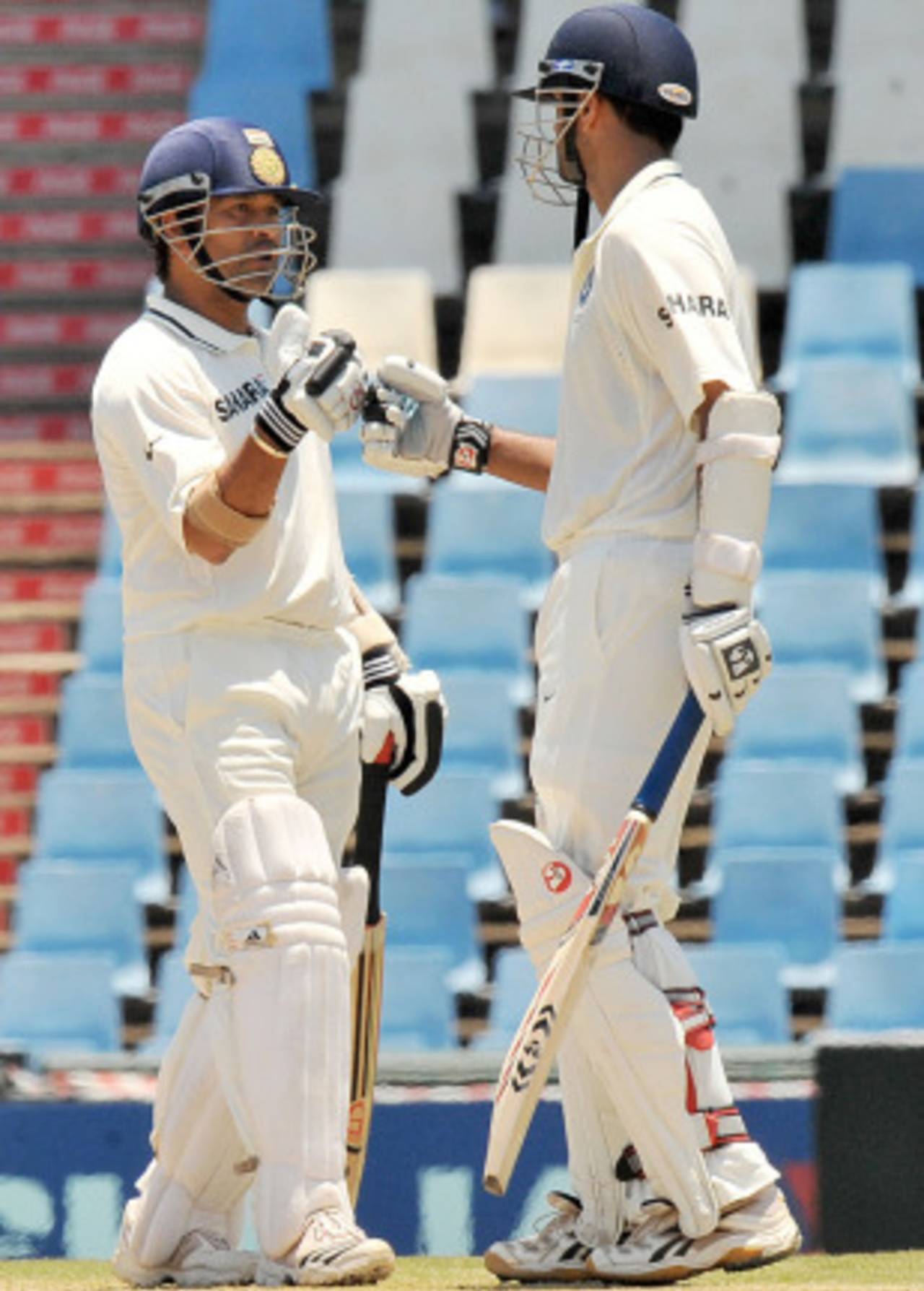India's shaky Lord's history
In 15 Test visits to the famous stadium, India have finished victorious only once and have lost ten times
Dileep Premachandran
19-Jul-2011

Only two half-centuries at Lord's for India's two most prolific Test batsmen • AFP
Victor Trumper and Viv Richards did it once. George Headley did it twice in the same match. Sir Garfield Sobers also did it two times, the second at the age of 37. Sir Donald Bradman missed out on a third just before his 40th birthday. Even Ajit Agarkar has achieved the feat.
Indian batsmanship's most prolific trio, however, with 37,000 runs and 117 centuries between them, have no centuries to boast of at Lord's. Between them, Sunil Gavaskar, Sachin Tendulkar and Rahul Dravid have played 22 innings at the ground considered the home of cricket. They have just four half-centuries between them. Dravid, with a 95 on debut in 1996, is the only one to have come close to three figures. Tendulkar averages 21.28, with a highest of 37 at the ground.
There are visiting teams that thrive on the Lord's ambience. Australia didn't lose there between 1934 and 2009. South Africa have won three of their last five Tests at Lord's. India, by contrast, are as ill at ease there as a sadhu at a black-tie dinner. You have to go back a quarter of a century, to a summer otherwise remembered for Diego Maradona and Boris Becker, for their only win at Lord's. Ten of the other 14 matches they've played have ended in defeat.
Few Indian batsmen have thrived there. Amar Singh scored a defiant half-century in India's inaugural Test, while the 1952 match is synonymous with Vinoo Mankad despite England emerging victorious yet again. He scored 72 in the first innings and followed that up with a superb 184, prompting the Wisden Almanack to report: "It was refreshing to see batsmen willing to make strokes, an art which many modern players have never learned. The fourth day, Monday, was memorable for the visit of the Queen and more wonderful batting by Mankad."
The pattern of poor results continued though, with the nadir reached in the summer of 42 (1974). With the world reeling from spiraling oil prices and recession, India's batsmen lasted just 17 overs in the second innings as Geoff Arnold and Chris Old made the ball do their bidding in helpful conditions.
Some pride was restored five years later, when Dilip Vengsarkar and Gundappa Vishwanath batted more than 300 minutes to save a match that India appeared certain to lose. Inclement weather helped, but the Almanack was especially generous in its praise of Vengsarkar's "tall and upright" play.
It was the start of an extraordinary love affair. In 1982, Vengsarkar made 157 in an Indian defeat, though that effort was almost eclipsed by Kapil Dev's astonishingly belligerent 55-ball 89. England may have gone past a small target with relative ease, but Kapil's display was in keeping with a summer that was illuminated by three of the game's greatest allround talents - Ian Botham and Imran Khan being the other two.
The victory in 1986 was again inspired by Vengsarkar's brilliant batsmanship. Graham Gooch made a first-day century, but few of the other batsmen mastered the seam-friendly conditions. "Off 170 balls in 266 minutes, his tenth Test century was one of classical elegance, charm and responsibility," says the Almanack. "Of the sixteen 4s in his unbeaten 126 (213 balls, 326 minutes) many came from handsome drives."
The man they called The Colonel, because of apparent similarities in style with CK Nayudu, had a fourth opportunity to score a hundred in 1990, but had to settle for a half-century in a game where Gooch was reprieved by Kiran More on 36 and went on to make a triple-century. England would win easily, despite a doughty hundred from Ravi Shastri and a dazzling one from Mohammad Azharuddin.
Azhar's innings appealed most to those that revel in clichés about "oriental" batting. It was also the response of a man who had gambled and failed horribly at the toss, and who saw all-out attack as the best way to unsettle a steady seam attack. The Almanack says: "Not a few strokes early in his innings would have been hard to excuse had they cost him his wicket; but his luck held, and a capacity Saturday crowd was treated to a rare exhibition of audacious, wristy strokeplay which, with 20 fours, took him into three figures off only 88 balls."
Six years later, Sourav Ganguly, derided by some as a 'quota' selection when the team left for England, batted seven hours for his 131 on debut. Dravid missed his landmark by a whisker and India's lack of decisiveness, coupled with English tail-end resistance, cost them the chance of a series-levelling victory.
Agarkar's nothing-to-lose 109 merely made the margin of defeat respectable in 2002 and there were two more batting meltdowns four years ago, when India were indebted to MS Dhoni and bad weather for a great escape on the final day.
With Virender Sehwag's shoulder problem having caused uncertainty and innuendo about the batting order, India once again head to Lord's as underdogs. Back in 1986, they arrived at HQ without a win in their previous 10 Tests, dating back nearly two years. Now, on the back of three of the most successful seasons that the national team has ever had, they must summon up the spirit of Mankad and Vengsarkar, with maybe a dash of Azhar, to emulate Kapil's side.
Dileep Premachandran is an associate editor at ESPNcricinfo